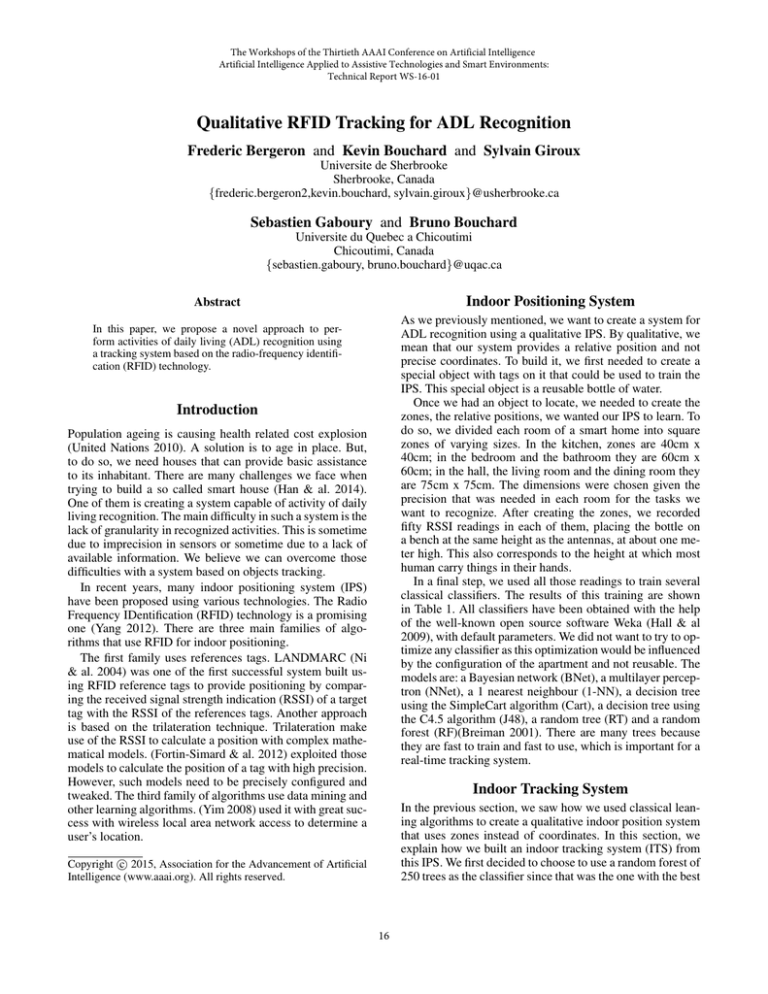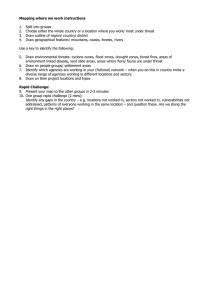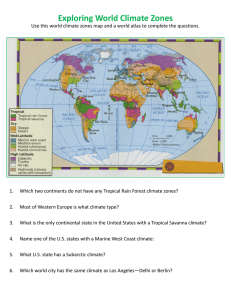
The Workshops of the Thirtieth AAAI Conference on Artificial Intelligence
Artificial Intelligence Applied to Assistive Technologies and Smart Environments:
Technical Report WS-16-01
Qualitative RFID Tracking for ADL Recognition
Frederic Bergeron and Kevin Bouchard and Sylvain Giroux
Universite de Sherbrooke
Sherbrooke, Canada
{frederic.bergeron2,kevin.bouchard, sylvain.giroux}@usherbrooke.ca
Sebastien Gaboury and Bruno Bouchard
Universite du Quebec a Chicoutimi
Chicoutimi, Canada
{sebastien.gaboury, bruno.bouchard}@uqac.ca
Indoor Positioning System
Abstract
As we previously mentioned, we want to create a system for
ADL recognition using a qualitative IPS. By qualitative, we
mean that our system provides a relative position and not
precise coordinates. To build it, we first needed to create a
special object with tags on it that could be used to train the
IPS. This special object is a reusable bottle of water.
Once we had an object to locate, we needed to create the
zones, the relative positions, we wanted our IPS to learn. To
do so, we divided each room of a smart home into square
zones of varying sizes. In the kitchen, zones are 40cm x
40cm; in the bedroom and the bathroom they are 60cm x
60cm; in the hall, the living room and the dining room they
are 75cm x 75cm. The dimensions were chosen given the
precision that was needed in each room for the tasks we
want to recognize. After creating the zones, we recorded
fifty RSSI readings in each of them, placing the bottle on
a bench at the same height as the antennas, at about one meter high. This also corresponds to the height at which most
human carry things in their hands.
In a final step, we used all those readings to train several
classical classifiers. The results of this training are shown
in Table 1. All classifiers have been obtained with the help
of the well-known open source software Weka (Hall & al
2009), with default parameters. We did not want to try to optimize any classifier as this optimization would be influenced
by the configuration of the apartment and not reusable. The
models are: a Bayesian network (BNet), a multilayer perceptron (NNet), a 1 nearest neighbour (1-NN), a decision tree
using the SimpleCart algorithm (Cart), a decision tree using
the C4.5 algorithm (J48), a random tree (RT) and a random
forest (RF)(Breiman 2001). There are many trees because
they are fast to train and fast to use, which is important for a
real-time tracking system.
In this paper, we propose a novel approach to perform activities of daily living (ADL) recognition using
a tracking system based on the radio-frequency identification (RFID) technology.
Introduction
Population ageing is causing health related cost explosion
(United Nations 2010). A solution is to age in place. But,
to do so, we need houses that can provide basic assistance
to its inhabitant. There are many challenges we face when
trying to build a so called smart house (Han & al. 2014).
One of them is creating a system capable of activity of daily
living recognition. The main difficulty in such a system is the
lack of granularity in recognized activities. This is sometime
due to imprecision in sensors or sometime due to a lack of
available information. We believe we can overcome those
difficulties with a system based on objects tracking.
In recent years, many indoor positioning system (IPS)
have been proposed using various technologies. The Radio
Frequency IDentification (RFID) technology is a promising
one (Yang 2012). There are three main families of algorithms that use RFID for indoor positioning.
The first family uses references tags. LANDMARC (Ni
& al. 2004) was one of the first successful system built using RFID reference tags to provide positioning by comparing the received signal strength indication (RSSI) of a target
tag with the RSSI of the references tags. Another approach
is based on the trilateration technique. Trilateration make
use of the RSSI to calculate a position with complex mathematical models. (Fortin-Simard & al. 2012) exploited those
models to calculate the position of a tag with high precision.
However, such models need to be precisely configured and
tweaked. The third family of algorithms use data mining and
other learning algorithms. (Yim 2008) used it with great success with wireless local area network access to determine a
user’s location.
Indoor Tracking System
In the previous section, we saw how we used classical leaning algorithms to create a qualitative indoor position system
that uses zones instead of coordinates. In this section, we
explain how we built an indoor tracking system (ITS) from
this IPS. We first decided to choose to use a random forest of
250 trees as the classifier since that was the one with the best
c 2015, Association for the Advancement of Artificial
Copyright Intelligence (www.aaai.org). All rights reserved.
16
Table 1: Accuracy for different learning algorithms on all datasets
Dataset
BNet
96,375
97,657
95,691
96,240
95,697
95,111
96,129
Hall
Living Room
Kitchen
Dinning Room
Bedroom
Bathroom
Average
NNet
51,125
91,257
83,491
93,840
86,485
87,482
82,280
1-NN
94,875
94,800
96,891
95,440
93,212
90,370
94,265
TZF
0,895
0,963
0,746
0,944
0,923
0,826
0,883
J48
96,875
92,057
96,418
95,040
92,849
91,630
94,144
RT
95,625
89,314
96,709
95,440
89,818
88,148
92,509
RF
97,750
97,600
98,891
96,640
96,485
96,074
97,240
We also want to try to learn activities using sequences of
names with simple, atomic activities like boiling water. A
second learning phase would then be to learn macro activities using the previously learned atomic activities. All steps
of this learning should be physically independent from the
configuration of our smart home. For example, it should be
easy to learn that taking a cup and coffee from the cupboard
means preparing coffee. If it is not enough, we could also
consider that a water recipient went from the sink zone to
the coffee maker zone, and the action should become clear.
Using this simple example, we see that several activities
do not need a complex and heterogeneous set of sensors to
be recognized. We do not actually need to know that coffee
maker is switched on and that water flown in the sink when
location information of used objects is enough. In fact, these
other sources of information could serve to increase precision on more complex activities rather than serve as the core
of the system. Another simple activity to recognize could be
cooking eggs. Then, we could combine those two (or more)
to determine that someone is making breakfast and, thus, realizing complex activity recognition.
Table 2: Neighbouring filter with the weighted moving average using factorial
Metric
Bedroom
Bathroom
Hall
Kitchen
Living room
Dining room
Average
Accuracy
Cart
95,625
92,400
96,400
95,200
91,515
90,266
93,5678
STZF
0,704
0,773
0,594
0,926
0,814
0,723
0,756
accuracy for a fast training. Then, we designed ten plausible
paths in each room that we would want to track the bottle
on, for a total of sixty paths (10 paths per room X 6 rooms).
One of the biggest issue we faced was that the bottle was
often teleporting to aberrant zones due to interference or bad
classification. To prevent this, we had to develop some filters. We first thought of a moving average of 10 readings
to regularize the readings and the effect of bad readings.
Then we weighted this moving average with different distributions (linear, factorial, exponential and logarithmic) and
found that a slowly decreasing weight was best for regularity. But, there was still occasional teleportation. So, we designed a second filter that limit movement to a neighboring
zone. Table 2 shows the accuracy obtained when combining
the moving average and the neighboring filter. There are two
metrics: the number of targeted zones found (TZF), and the
sequential number of target zones found (STZF).
References
Han, J.; Choi, C.-S.; Park, W.-K.; Lee, I.; and Kim, S.-H. 2014.
Smart home energy management system including renewable energy based on zigbee and plc. Consumer Electronics, IEEE Transactions on, 60(2):198–202.
Ni, L. M.; Liu, Y.; Lau, Y. C.; and Patil, A. P. 2004. Landmarc: indoor location sensing using active rfid. Wireless networks,
10(6):701–710.
Yim, J. 2008. Introducing a decision tree-based indoor positioning
technique. Expert Systems with Applications, 34(2), 1296–1302.
Hall, M.; Frank, E.; Holmes, G.; Pfahringer, B.; Reutemann, P.; and
Witten, I.H. 2009. The WEKA Data Mining Software: An Update,
SIGKDD Explor., vol. 11, no. 1.
Breiman, L. 2001. Random forests. Machine learning, 45(1), 5–32.
Fortin-Simard, D.; Bouchard, K.; Gaboury, S.; Bouchard, B.; and
Bouzouane, A. 2012. Accurate passive rfid localization system for
smart homes. In Networked Embedded Systems for Every Application (NESEA), 2012 IEEE 3rd International Conference on, pages
1-8. IEEE.
Yang, L., Cao, J., Zhu, W., and Tang, S. 2012. A hybrid method
for achieving high accuracy and efficiency in object tracking using passive RFID. In Pervasive Computing and Communications
(PerCom), 2012 IEEE International Conference on (pp. 109–115).
IEEE.
U. N. D. of Economic. 2010. World population ageing 2009, volume 295. United Nations Publications.
ADL recognition
In this section, we present some ideas we have for the actual ADL recognition. A promising approach is to use the
interaction and proximity between objects to determine activities. Only by knowing what objects moved it should be
possible to infer basic activities. Then, by knowing what are
the last zones visited by an object we could predict what
should come next, either by learning long sequences or by
using an expert to build a library. To make our system independent from our lab configuration, we could also abstract
the zones to name of the parts of a house, like sink, oven, and
so on. Of course, given the size of our zones, it would mean
that the new zone known as the oven in fact contains many
distinct zones. We see it as an advantage as it also allows
multiple objects to be considered at the same place when
they are in fact right next to one another.
17



